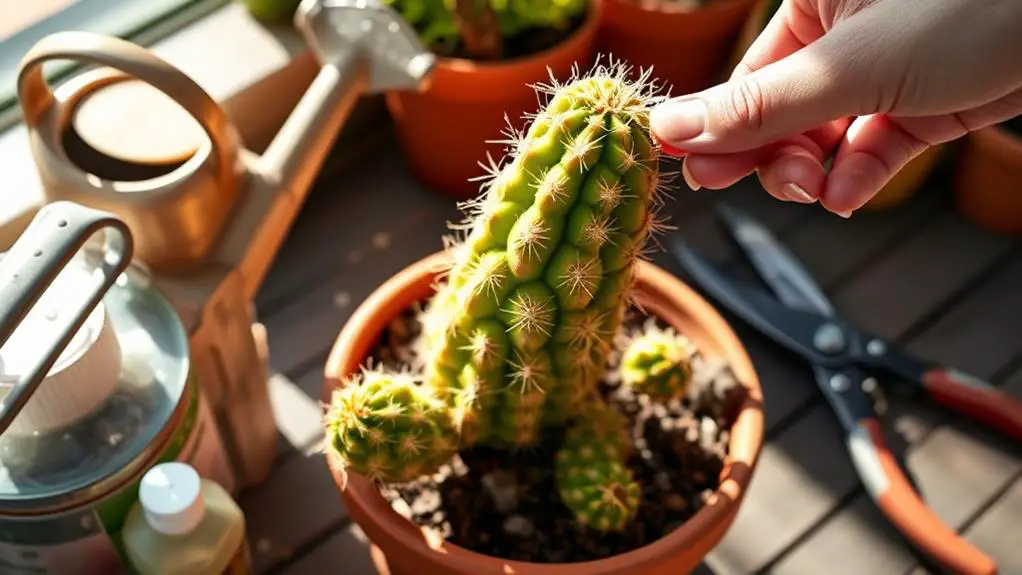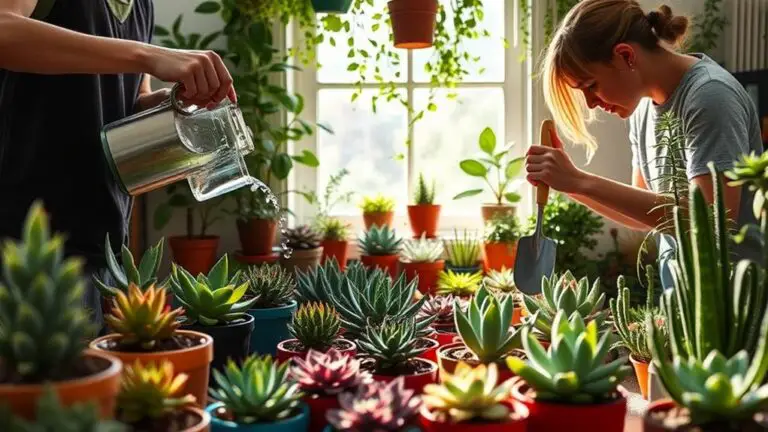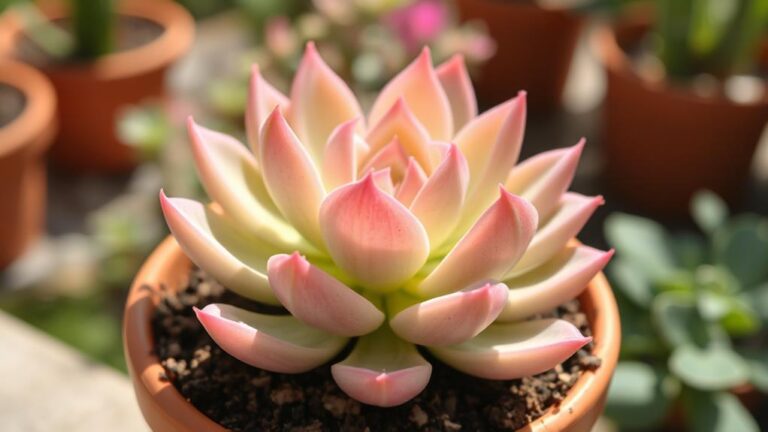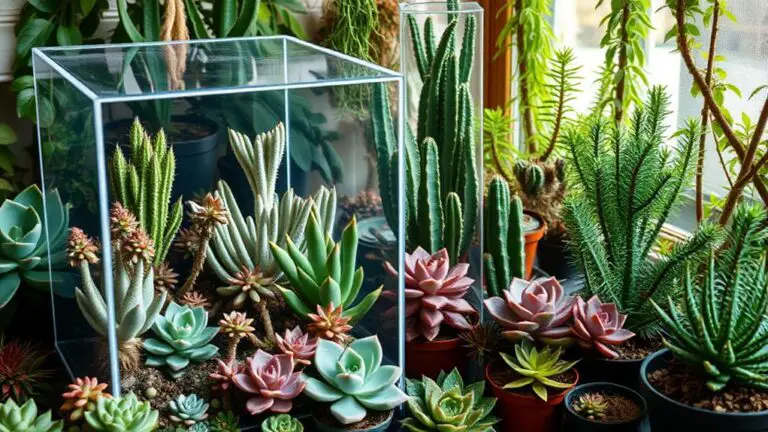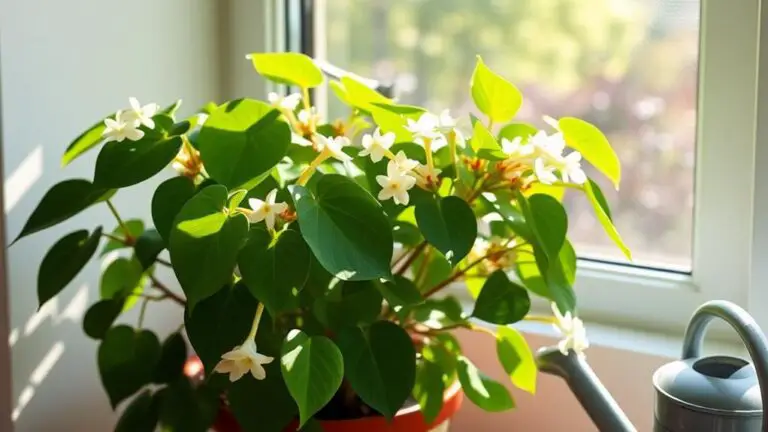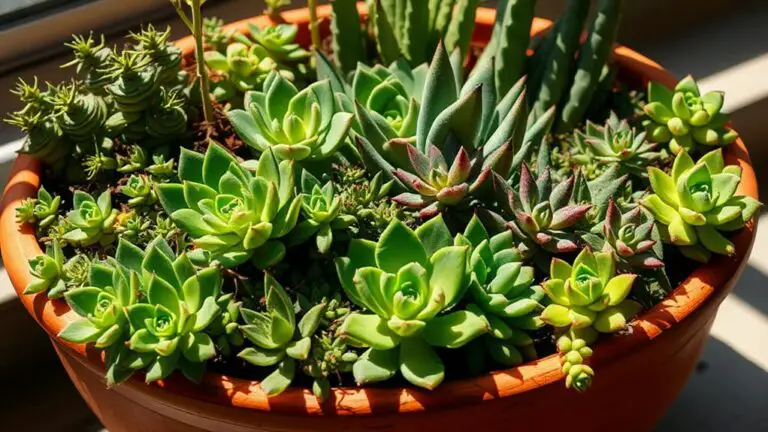7 Steps to Care for Your Corn Cob Cactus
When it comes to caring for your Corn Cob Cactus, there are seven essential steps you shouldn't overlook. Start by ensuring it gets the right amount of sunlight, but avoid those intense afternoon rays that can cause damage. Watering is another vital aspect, and you'll need to be mindful to let the soil dry out completely between sessions. The type of soil and its drainage capabilities can't be ignored either. As you navigate these steps, you'll find that each one plays a pivotal role in maintaining the health and vibrancy of your cactus. Curious about the rest? Let's explore further.
Understand Toxicity and Safety

When caring for a Corn Cob Cactus, it's important to understand its toxicity and safety concerns. This plant contains milky latex sap that can cause skin irritation and allergic reactions upon contact. To protect yourself, always wear gloves when handling the cactus. If the sap touches your skin, wash it off immediately to avoid irritation.
Ingestion of any part of the Corn Cob Cactus can lead to unpleasant symptoms like nausea, vomiting, and diarrhea. It's vital to keep the plant out of reach of children and pets to prevent accidental ingestion. If someone ingests the plant, contacting Poison Control is necessary to get the right help quickly.
Eye contact with the sap can result in significant irritation and potentially severe reactions. If sap gets into your eyes, rinse them with plenty of water and seek medical attention immediately.
Understanding the plant's toxic nature helps guarantee safety. By practicing safe handling techniques and being aware of the risks, you can enjoy your Corn Cob Cactus without worry.
Provide Optimal Sunlight

Providing ideal sunlight is essential for the health and growth of your Corn Cob Cactus. Place your cactus within one foot of a south-facing window. This guarantees it gets bright light and direct sunlight for at least six hours daily.
Remember, though, to avoid exposing it to intense afternoon sun. The strong rays can cause sunburn and damage its delicate structure.
Regularly monitor light conditions in your space. Insufficient light can lead to stunted growth and poor health for your cactus. If you notice it's not thriving, you might need to adjust its location.
During winter, natural light can be limited. In this case, consider using supplemental lighting to support your cactus's growth during shorter days.
To keep your cactus healthy and looking good, rotate the plant periodically. This promotes even light exposure and prevents it from leaning toward the light source.
By carefully managing the light it receives, you'll help your Corn Cob Cactus grow strong and vibrant. With these steps, you're well on your way to providing the best sunlight it needs.
Just keep an eye on it, and adjust as necessary!
Water Sparingly
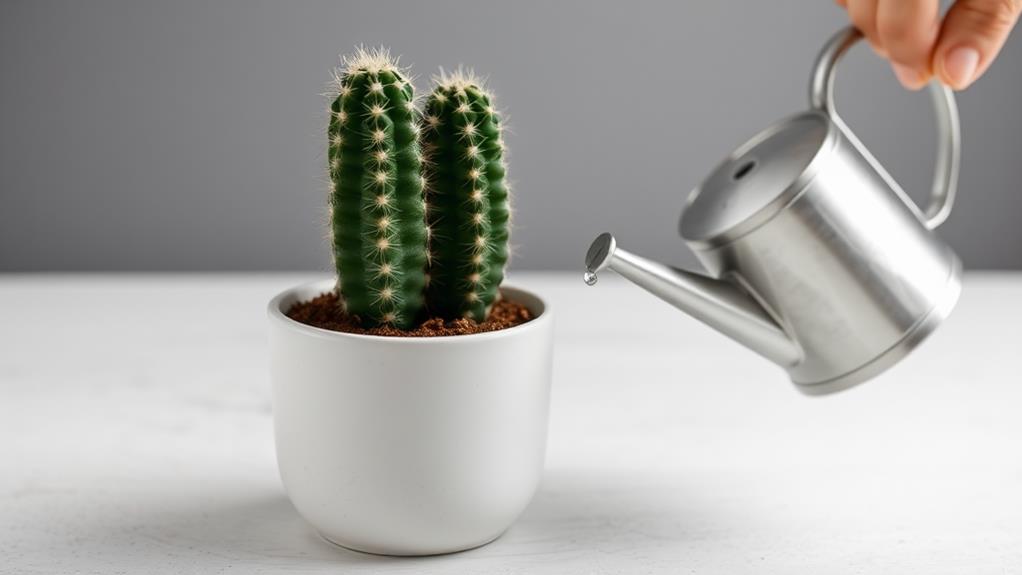
Making sure your Corn Cob Cactus receives the right amount of water is just as important as providing it with ideal sunlight. To maintain a healthy cactus, it's essential to water sparingly.
Start by watering thoroughly but infrequently. Allow the top inch of soil to dry out completely before you water again. During the growing season in spring and summer, aim to water about once a week. However, as fall and winter approach, reduce watering to about once a month, as the cactus enters its dormancy period.
Overwatering is a common issue that can lead to root rot, which is harmful to your cactus. Confirm your pot has drainage holes to prevent water from accumulating at the bottom. Always check the soil moisture before watering. If the soil feels damp, wait until it dries out completely. This helps avoid stressing your plant.
Environmental conditions also play a role. In higher humidity, you might need to water less frequently. Adjust your watering schedule accordingly to make sure your cactus thrives.
Use Well-Draining Soil
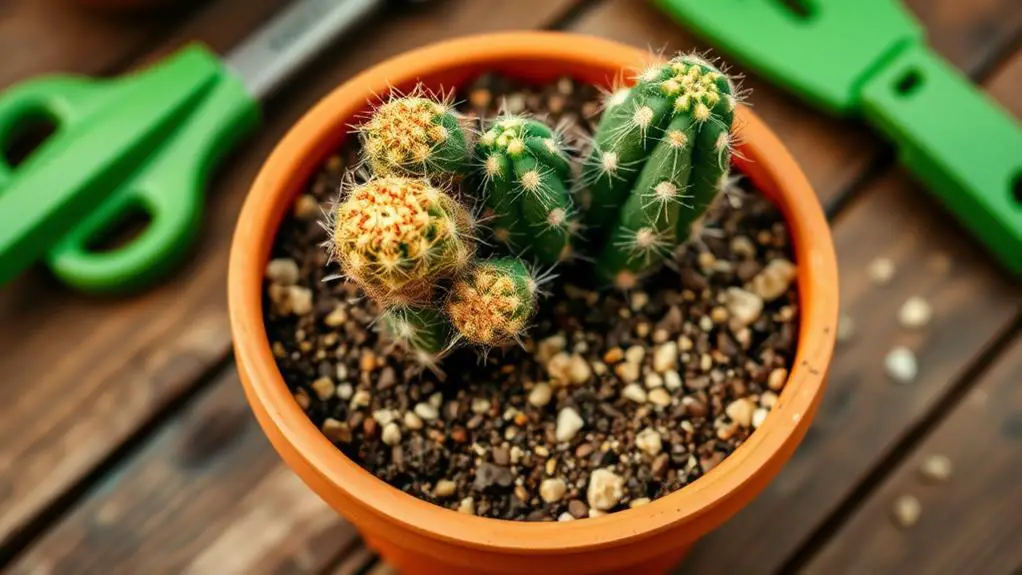
Selecting the right soil is essential for the health of your Corn Cob Cactus. Using a commercial cactus mix guarantees your plant gets the drainage it needs. You can also create your own by mixing potting soil with perlite or pumice. This combination provides excellent drainage, preventing water from sitting at the bottom of the pot, which can lead to root rot.
Make sure the pot has good drainage holes. They allow excess water to escape, keeping the root system healthy. Repot your cactus every 2-3 years or whenever you see the soil becoming compacted. Fresh, well-draining soil will provide your plant with essential nutrients.
When watering, do it thoroughly but infrequently. Let the top inch of soil dry out completely before the next watering. This practice keeps your Corn Cob Cactus happy and healthy.
Here's a quick guide to soil choices:
| Option | Components | Benefits |
|---|---|---|
| Commercial Mix | Cactus soil | Ready to use, ideal drainage |
| DIY Mix | Potting soil, perlite | Customized, retains less moisture |
| Pot with Holes | Any soil type | Guarantees good drainage |
Maintain Ideal Temperatures

To keep your Corn Cob Cactus happy, aim for temperatures between 60°F and 80°F, as this mimics its natural arid environment.
While it can handle hotter days, make certain to shield it from the intense midday sun to avoid heat stress.
In winter, keep the temperature above 50°F to guarantee your cactus stays healthy and frost-free.
Temperature Range Preferences
Wondering how to keep your Corn Cob Cactus thriving? Understanding its temperature range preferences is essential. This cactus hails from South Africa, so it does best in temperatures between 60°F to 80°F. This range mimics its native habitat, ensuring it grows strong and healthy.
While it can handle slightly higher temperatures, be cautious with intense midday sun as it can cause damage.
During winter, it's vital to maintain the minimum winter temperature above 50°F. Keeping it above freezing is important for its health and longevity. If temperatures drop too low, your cactus may experience stress, which can affect its growth and overall well-being.
Regularly monitor temperature fluctuations, especially if you've moved your cactus indoors during colder months. Consistently checking the temperature helps you make any necessary adjustments to keep your plant comfortable.
Seasonal Temperature Adjustments
Maintaining the ideal temperature for your Corn Cob Cactus throughout the year is vital to its health. Aim to keep it between 60°F to 80°F for peak growth. This range mimics the cactus's native South African habitat, providing the best conditions for thriving.
During winter, it's essential to make sure temperatures don't drop below 50°F. Cold temperatures can cause frost damage, which your cactus won't appreciate. If you notice temperatures dropping, consider moving your cactus indoors or to a warmer spot.
When the weather heats up, be cautious of intense midday sun. While your cactus loves light, too much direct sunlight can lead to sunburn. Instead, place it where it gets plenty of indirect sunlight.
In winter, the days are shorter and natural light decreases. This is when supplemental lighting comes in handy. Providing extra light helps maintain growth levels even in low-light conditions.
Always monitor your cactus's environment as seasons change. Adjusting its placement and using tools like thermometers can help. By keeping the temperature within the ideal range, you'll guarantee your Corn Cob Cactus stays healthy and vibrant all year round.
Prune and Propagate
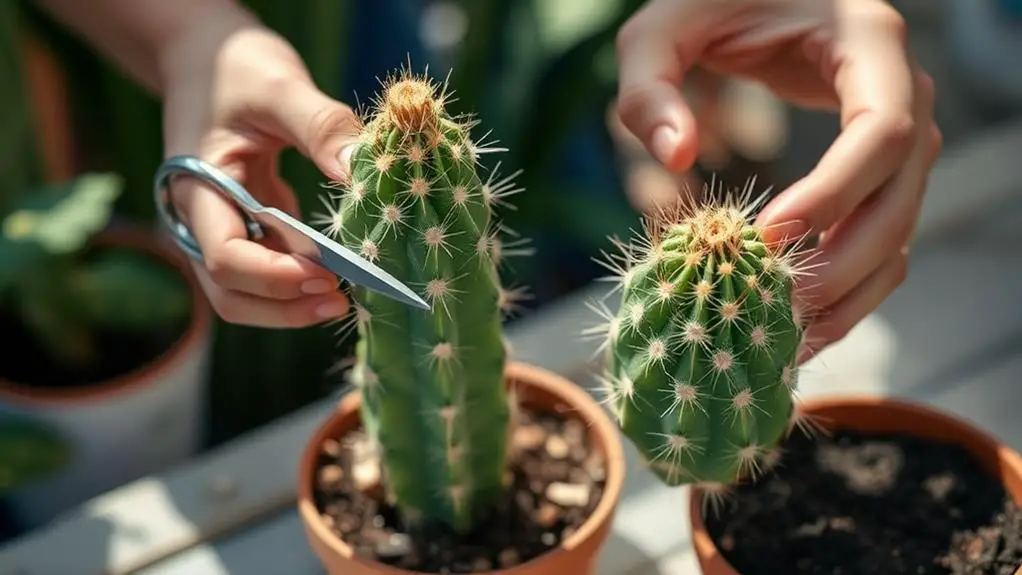
Pruning and propagating your Corn Cob Cactus guarantees it stays healthy and vibrant. Start by pruning during the active growth season in spring or early summer. Use clean, sharp tools to remove any dead, damaged, or diseased stems. This helps prevent infections and encourages new growth.
For propagation, choose healthy, non-flowering stem cuttings. Let the cuttings dry and callous over for a few days before planting them in well-draining soil. This step is essential because it prevents root rot, which can occur if the cuttings are too moist when planted.
Alternatively, you can divide offshoots with roots from the parent plant during repotting. Make sure each division has a healthy root system to guarantee they grow well.
After planting, place your cuttings or divisions in indirect light. Direct sunlight can be too harsh and stressful for them at this stage.
Monitor the soil moisture closely. Avoid watering for a few days post-pruning or transplanting to allow for healing. Overwatering can lead to root rot, so be cautious.
Monitor for Pests and Diseases
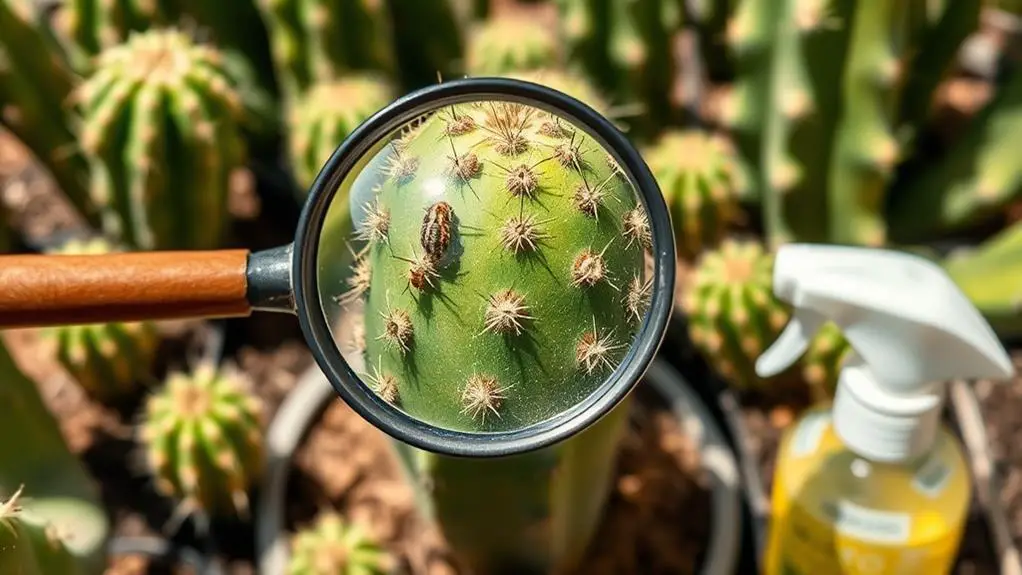
Keep an eye out for common pests like mealybugs and spider mites on your Corn Cob Cactus, as they can cause damage if not treated.
Also, watch for powdery mildew, which looks like a white, powdery substance and signals too much humidity or poor airflow.
To keep your cactus healthy, use insecticidal soap or neem oil for pests, let the soil dry between waterings to avoid root rot, and make sure the pot has good drainage.
Common Pest Infestations
One of the most significant aspects of caring for your Corn Cob Cactus is monitoring for common pest infestations. Common pests like mealybugs and spider mites can cause substantial damage if not addressed promptly. Regularly inspect the undersides of leaves and the soil for signs of pest activity, such as webbing, white cotton-like masses, or discolored foliage.
Here's a quick reference table for common issues and solutions:
| Pest/Disease | Symptoms | Solution |
|---|---|---|
| Mealybugs | White cotton-like masses | Insecticidal soap |
| Spider mites | Webbing, discolored foliage | Neem oil |
| Powdery mildew | White powdery spots on leaves | Improve air circulation |
| Root rot | Mushy roots, wilting | Repot in well-draining soil |
| General pests | Visible insects, weak growth | Regular inspection and cleaning |
To manage infestations, consider using insecticidal soap or neem oil. Apply these according to product instructions to guarantee effective treatment. Maintaining good air circulation around the plant and avoiding overhead watering can minimize the risk of fungal diseases like powdery mildew. If you notice root rot from overwatering, it's essential to remove the affected roots and repot the cactus in fresh, well-draining soil to restore plant health. By staying vigilant and taking quick action, you can keep your Corn Cob Cactus thriving and pest-free.
Disease Prevention Tips
Consistent vigilance is essential for keeping your Corn Cob Cactus healthy and disease-free. Regularly inspect your plant for common pests like mealybugs and spider mites. These tiny creatures can cause significant damage if not dealt with promptly. Make it a habit to check your cactus frequently and act quickly if you notice any unwelcome visitors.
To prevent root rot, guarantee your potting mix has excellent drainage. Root rot is often caused by overly moist conditions, so make sure your cactus isn't sitting in waterlogged soil.
Additionally, monitor the humidity levels around your plant. High humidity can lead to powdery mildew, which appears as white, powdery spots on the cactus surface. Keeping the plant in a well-ventilated area helps manage humidity and reduces the risk of fungal infections.
If you do spot pests, use insecticidal soap or neem oil to treat the problem. These solutions are effective and safe for your plant.
Effective Treatment Methods
Caring for your Corn Cob Cactus means staying proactive about pests and diseases. Regularly inspect your cactus for common pests like mealybugs and spider mites. These tiny insects can cause significant damage if you don't treat them quickly.
Look for signs like white, powdery spots, which indicate powdery mildew. To prevent this, guarantee your plant has adequate air circulation and reduce humidity around it.
Check the soil moisture closely, as overly wet conditions can lead to root rot. Make sure your pot has good drainage to keep your cactus healthy. If you spot an infestation, use insecticidal soap or neem oil. Apply it thoroughly to the affected areas and repeat every few days until the pests are gone.
Also, be on the lookout for yellowing leaves or stunted growth, which can signal nutrient deficiencies or root rot. If you see these signs, review your watering and fertilization practices.
Make sure you're not overwatering and that your cactus is getting the nutrients it needs. By staying vigilant and taking these steps, you'll keep your Corn Cob Cactus thriving and free from pests and diseases.
Frequently Asked Questions
How Fast Does Corn Cob Cactus Grow?
Your Corn Cob Cactus can grow 8 to 10 inches in a year or two if you provide ideal light, warmth, and regular feeding. Growth slows in winter dormancy, so guarantee the best conditions during spring and summer.
Why Is My Corn Cob Cactus Turning Brown?
Your Corn Cob Cactus is turning brown due to overwatering, insufficient sunlight, or environmental stress. Make certain it gets six hours of indirect sunlight, avoid drafts, and let the soil dry out before watering again to prevent root rot.
How to Care for Cactus Plants Indoors?
Place your cactus in bright, direct sunlight for six hours daily. Water sparingly, letting the top inch of soil dry out. Use well-draining soil, fertilize every four to six weeks, and maintain temperatures between 60°F to 80°F.
What Temperature Do Corn Cob Cactus Like?
Your Corn Cob Cactus loves temperatures between 60°F and 80°F. Keep it above 50°F in winter to avoid damage. Protect it from intense midday sun if it gets hotter, and remember, it thrives in low-humidity conditions.
Conclusion
Taking care of your Corn Cob Cactus isn't hard if you follow these steps. Give it plenty of bright sunlight, but don't let it get too hot. Water it just enough and use well-draining soil. Keep it comfortable with the right temperatures, prune it during growth, and watch out for pests. Don't forget to use healthy cuttings to propagate. With these tips, you'll enjoy a thriving cactus that's a joy to grow. Happy gardening!

